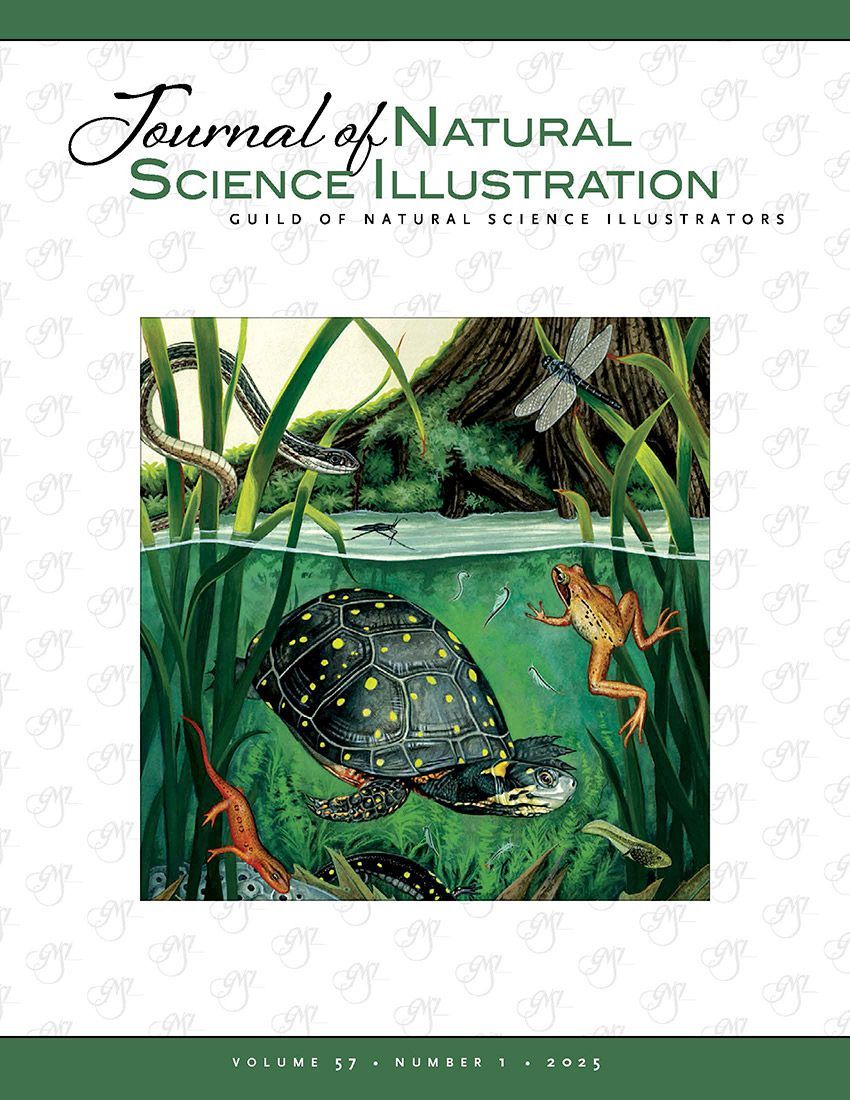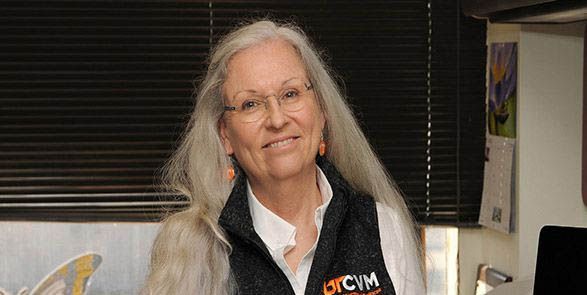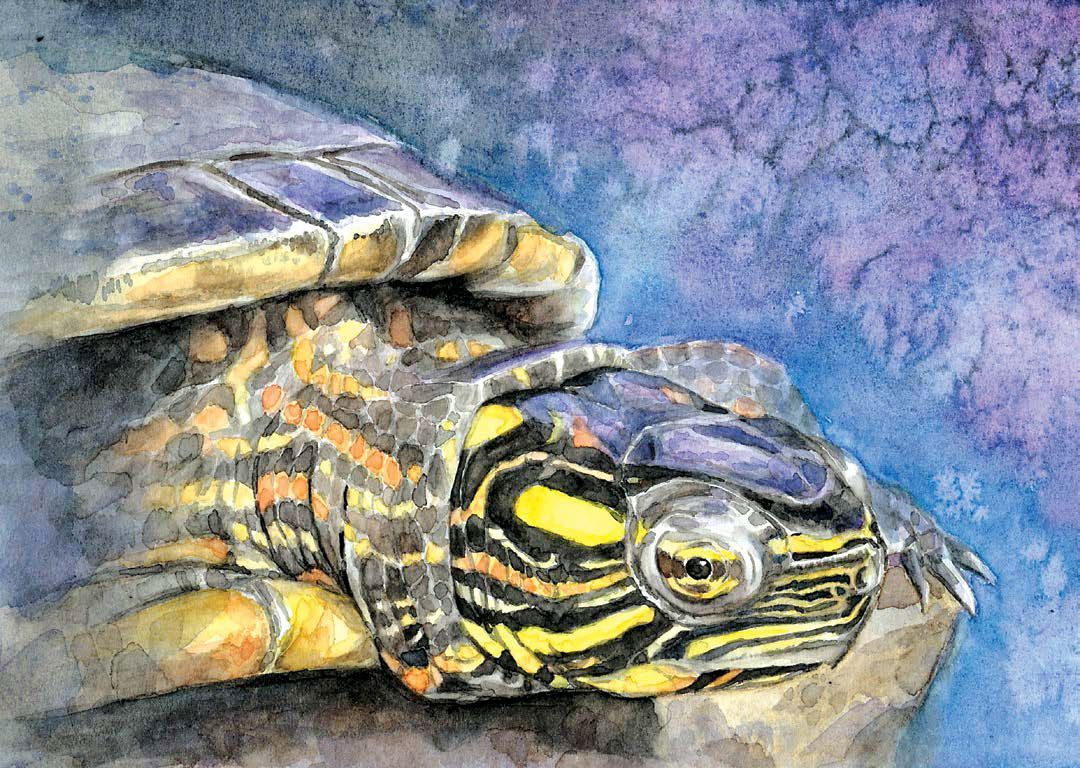In Memoriam: Elaine R. S. Hodges
– All images ©Elaine Hodges, unless otherwise noted.
My sincere thanks to Kris Kirkeby and Steve Hodges, who helped considerably in collecting information about Elaine and Ron, and also making Elaine’s illustrations available. — Trudy Nicholson
Casting our minds back 51 years, we find two young natural science illustrators at the Smithsonian National Museum of Natural History. Carolyn Bartlett Gast and Elaine R. S. Hodges had noticed the lack of connection among staff illustrators and had become the prime movers to bridge the gap. In order to do that, Carolyn planned illustrators’ luncheons with programs related to the media that would be helpful to these previously isolated artists. This served as a means to introduce illustrators to one another and for them to recognize the benefits of coming together. Carolyn found Elaine to be a willing ally and, as Carolyn saw it, Elaine had enthusiasm for the project as well as access to a typewriter—and could type. With that skill they produced elegant invitations and descriptions of the programs. Their success in this endeavor led to the founding of the Guild of Natural Science Illustrators on December 2, 1968, and the connection among natural science illustrators that we’ve all enjoyed for 51 years. Thus began a lifelong effort by Elaine to bring together people who specialized in the art of seeing—the art of perceiving an object, not just looking at it. All of this in the service of science.
The Guild started with 21 charter members. The first meetings were held at the National Museum of Natural History with Elaine typing announcements and descriptions of the meetings. As the Guild grew these typed up notes became our Guild Newsletter. As new members joined the Guild, Elaine sent along with the Newsletters several technique sheets that each described a specific artistic technique. Later these technique sheets inspired the Guild Handbook of Scientific Illustration, with Elaine at the helm. The benefits of each Guild expansion and new outgrowth that Elaine created resulted in an increase in Guild membership, which now it reaches around the world to multiple countries.
The driving force that led Elaine to these many roles in the Guild was part of her innate persona. And what led her to the field of art was her natural artistic talent and interest shown during her earliest years, leading to youthful studies at the Corcoran Gallery of Art in Washington D.C. where her family lived. Her artistic plans were sidetracked by her mother’s wishes for her to try for the stage. Not a theatrical performer at heart, she finally found the freedom to study at Wilson Teachers College for a year, and then received a scholarship to the Pratt Institute in New York, where she further developed her portrait painting skills. In 1965, on her return to Washington D.C. after a failed marriage, she discovered scientific illustration. That happened by chance. Elaine had taken a job as clerk at the National Museum of Natural History and was employed there for only a few weeks when, during a conversation with a friend, who was working as an illustrator at the Museum, she found out that another illustrator was needed to draw amphipods for Dr. Jerry Barnard there at the Museum, at a higher salary than her clerk’s job paid. Taking that job gave her the entry to the rest of her life, despite never having done similar work.
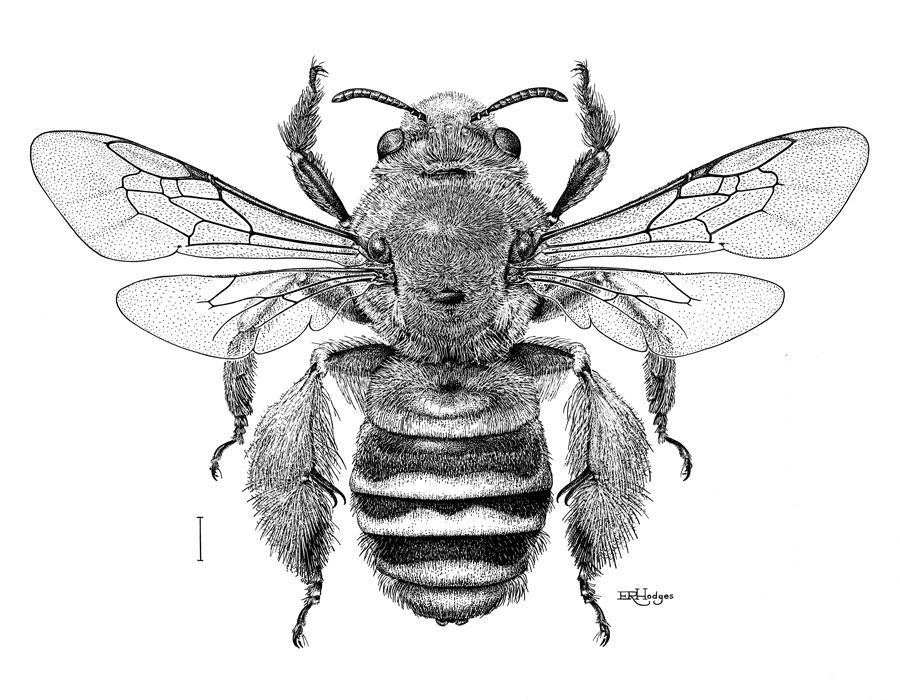
Diadasia rinconis Cockerell (female) (Hymenoptera: Apidae), ink on scratchboard, 1981. ©Smithsonian Institution
Drawing Dr. Barnard’s amphipods turned out to be a very natural blend of her interest in portraiture and science. She had no problem using a microscope, which seemed like a normal extension of her eyes, revealing a fascinating world of organic microstructures.
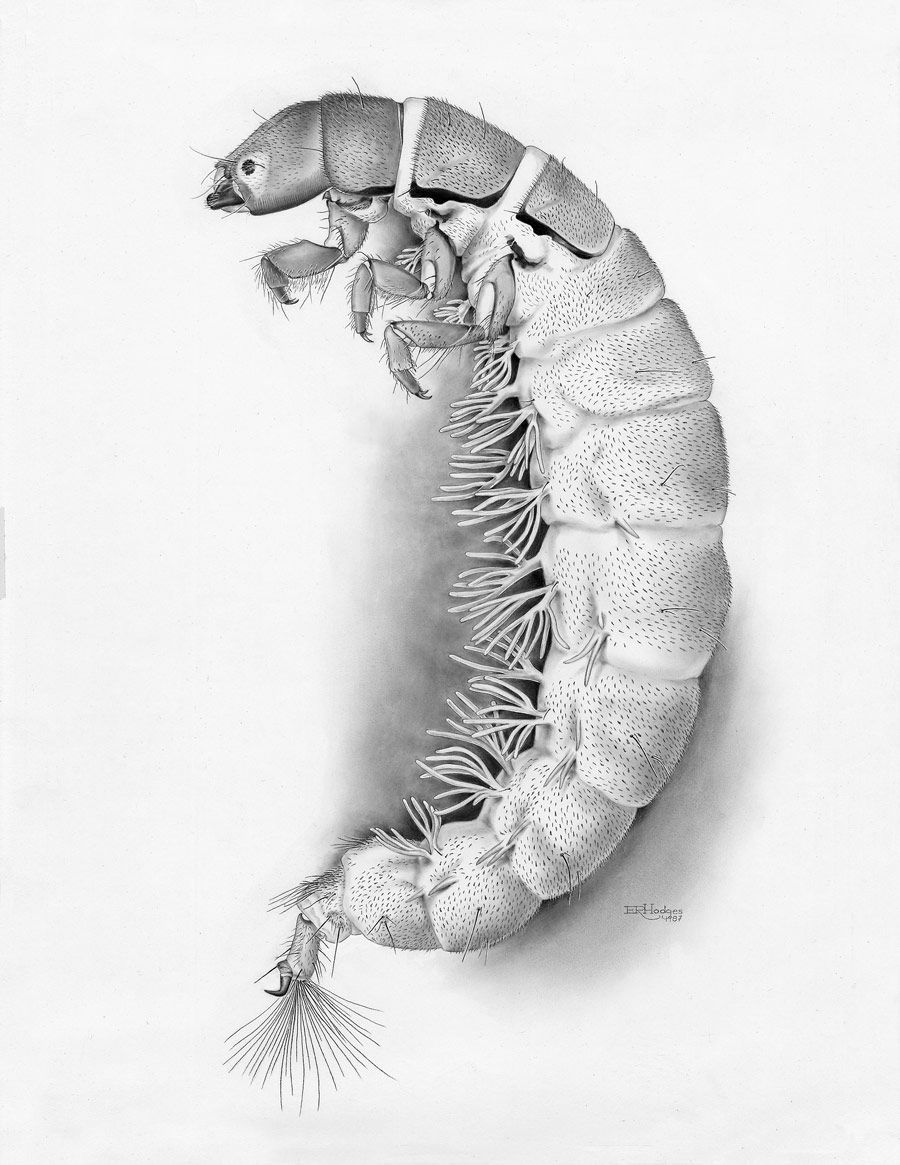
Caddisfly larvae Smicridea annulicornis (Trichoptera: Hydropsychidae), carbon dust and diluted ink on Ross board no.00, 1987. ©Smithsonian Institution
Neotropical Caddisflies XXXIX: The Genus Smicridea in the Chilean Subregion. No. 472. Smithsonian Contributions to Zoology, 1989.
In 1966 Dr. Barnard moved to Hawaii and Elaine, remaining at the Smithsonian, moved to the Southeast Asia mosquito project where she illustrated for 41⁄2 years, also doing contract work for other departments, drawing such subjects as ostracods and bird parasites. During that time she researched, wrote, and illustrated a paper on mosquitoes and found the research aspect of the experience to be exciting. This work increased her interest in entomology and she also became interested in a particular USDA entomologist, which led to the marriage of Dr. Ronald W. Hodges and Elaine in June 1967. Elaine described the event as elevating her to a perpetual Cloud 9. Their marriage was fulfilling for both. Ron had worked for years on the series Moths of America North of Mexico, Including Greenland, with Elaine doing the illustrations. They made quite a team. They were working in entomology, where Elaine became a prominent figure in her field, and Ron having achieved similar status in his field. They formed a happy family with two sons, Steve and Larry.
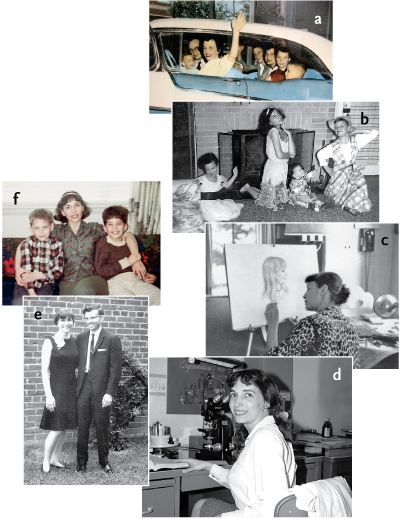
(a) Car: Elaine’s mom loved to enter contests. A publicity photo taken of the family in one of her winnings. (left to right) Joel (youngest child), father Sam, mother Pat, Sol (oldest brother), Elaine (oldest child), Carolyn (younger sister), and Irv (middle child), 1955 (© unknown). (b) Play acting. (left to right) Carolyn, Elaine, Irv, and Sol, (Joel not yet born), 1948. (c) Elaine works on a portrait of a young girl (Jennifer Adams), 1969. (d) Elaine at her microscope, mid- 1970s.(e) Elaine and Ron on their wedding day, June 1967. (f) (left to right) Son Larry, mom Elaine, and son Steve, 1965.
Elaine’s artwork was impeccable—distinctive yet accurate. She created memorable habitus images of entomological specimens, becoming a master of multiple techniques. In an inventory she kept, there were 93 double-sided pages with 38 entries per page—a total of 3,534 illustrations!
But beyond her skill, her importance became that of a mentor to young illustrators, providing advice, opportunities, and encouragement to become involved in the community of science illustrators.
Under Elaine’s guidance, as the Guild moved into the 1970’s, still early in its existence, it reached out to many isolated natural science artists scattered across the country and provided them with a packet of newly organized technique sheets that described a number of artistic techniques, their development, materials and tools, and examples, written and illustrated by artists who used the techniques. Over the years, these were polished and added to. It was these technique sheets that formed kernels of ideas for the Guild Handbook of Scientific Illustration, edited by Elaine, sponsored by the Guild, and published by Van Nostrand Reinhold in 1989. A total of 45 authors and 176 illustrators contributed to this book that took 13 years to produce. This was a massive job of editing for Elaine, needing careful oversight for each page. It was a frustrating task requiring Elaine to keep each artist/author on schedule. This book is considered the modern “Bible” of scientific illustration by artists in the field, by scientists interested in illustration, and by libraries across the nation. It has received four book awards. In 1995 it was in its third printing. It is still available, and still fulfilling the need for such a complete source of information in a world that is becoming more visual in its communication needs at an ever increasing pace. When published, the first edition was so successful that Elaine moved on to a second edition, which was published by John Wiley and Sons, Inc. in 2003. Through this set of two books, she shares with us a great wealth of information and lays the groundwork for professional standards in our field.
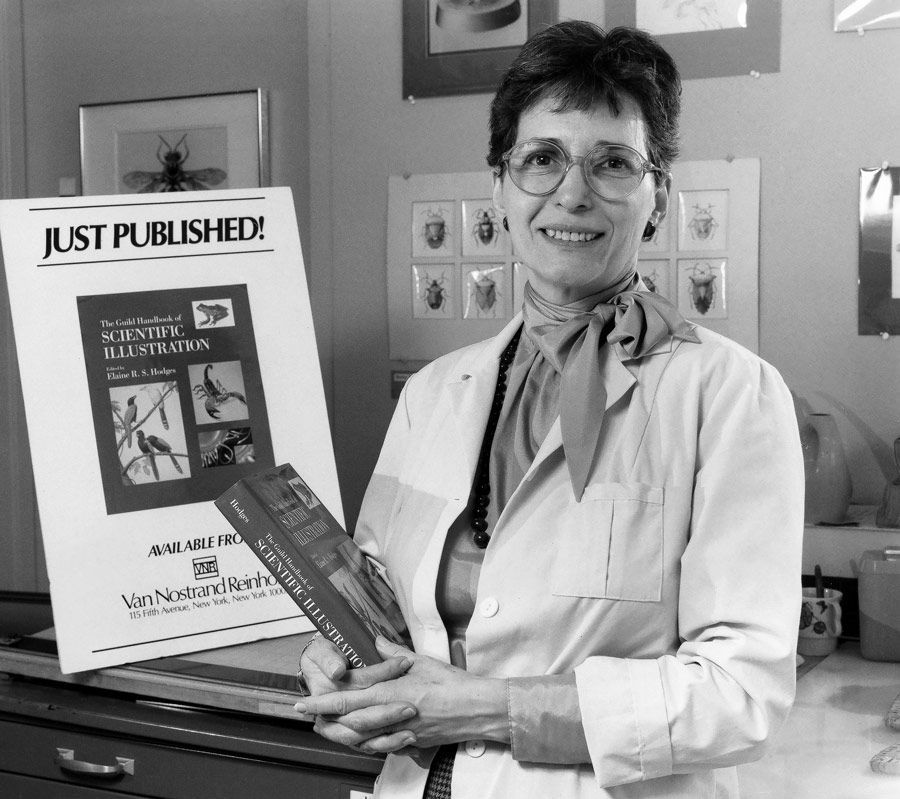
Elaine poses for a publicity photo in her office after the release of the first edition on the Guild Handbook of Scientific Illustration, 1989. ©Smithsonian Institution
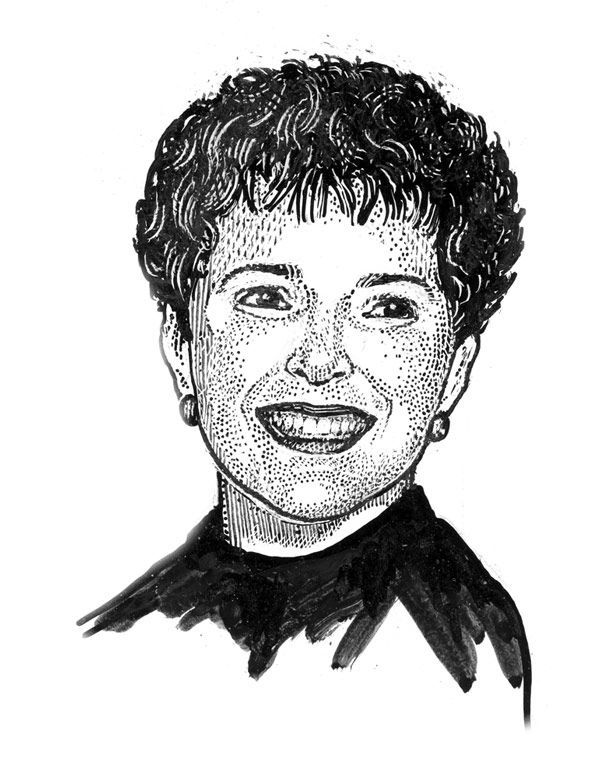
A scratchboard portrait of Elaine created by Trudy Nicholson, one of a collection Trudy created of Guild founders, 2008. ©Trudy Nicholson
Elaine was deeply interested in entomology and had been active in several national entomology organizations. She was Vice President of the International Lepidopterists’ Society. Elaine had other far-reaching interests beyond art, science, and entomology. The diversity of her interests ranged from international cooking to opera performances. Both she and Ron loved music and not only attended symphony events, but Elaine also sketched while attending them. This collection of sketches was donated to the University of Oregon Music School, where they are displayed in the Eugene Bach Festival headquarters of Berwick Hall. Two nonprofit organizations that Elaine supported were the Wedge Entomological Research Foundation and the Chamber Music Series of the University of Oregon School of Music.
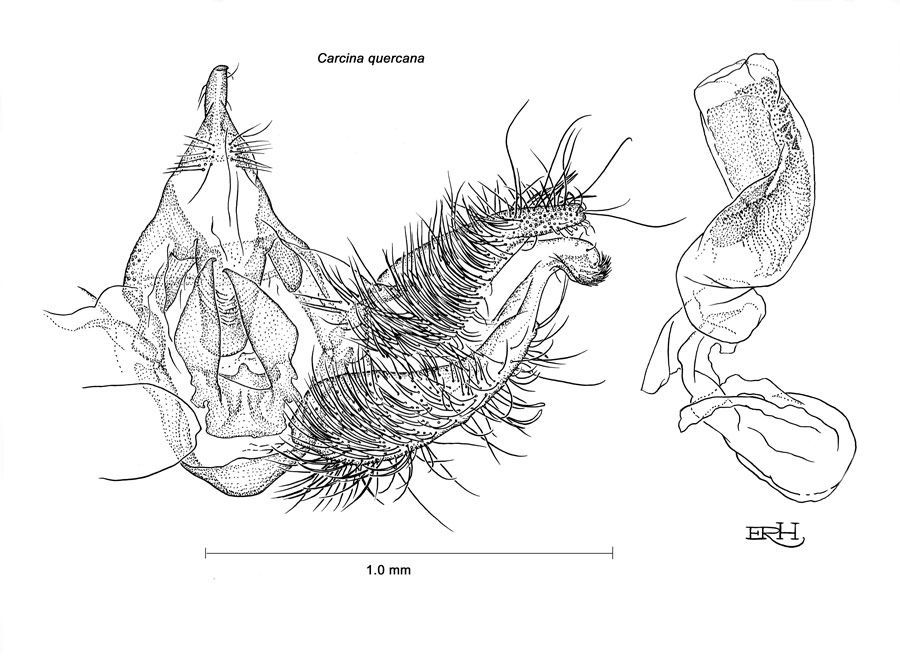
Moth Carcina quercana (male genitalia), pen and ink, 1981. ©Smithsonian Institution
Moths of America North of Mexico Gelechiodea by R. W. Hodges pub.
Among the awards she has won, and perhaps the most meaningful to Elaine, was the GNSI Distinguished Service Award in 1995. In the Guild she had served as Correspondence Secretary, Vice President, and President. She created an exhibit titled Science and Art: 150 Years of Smithsonian Research with the Smithsonian Historian, for the Sesquicentennial Celebration of the Smithsonian.
Another very meaningful award she received was the Ranice W. Crosby Distinguished Achievement Award For Pioneering of the Guild of Natural Science Illustrators. It was given on May 26, 2006, by the Johns Hopkins University School of Medicine's Department of Art as Applied to Medicine.
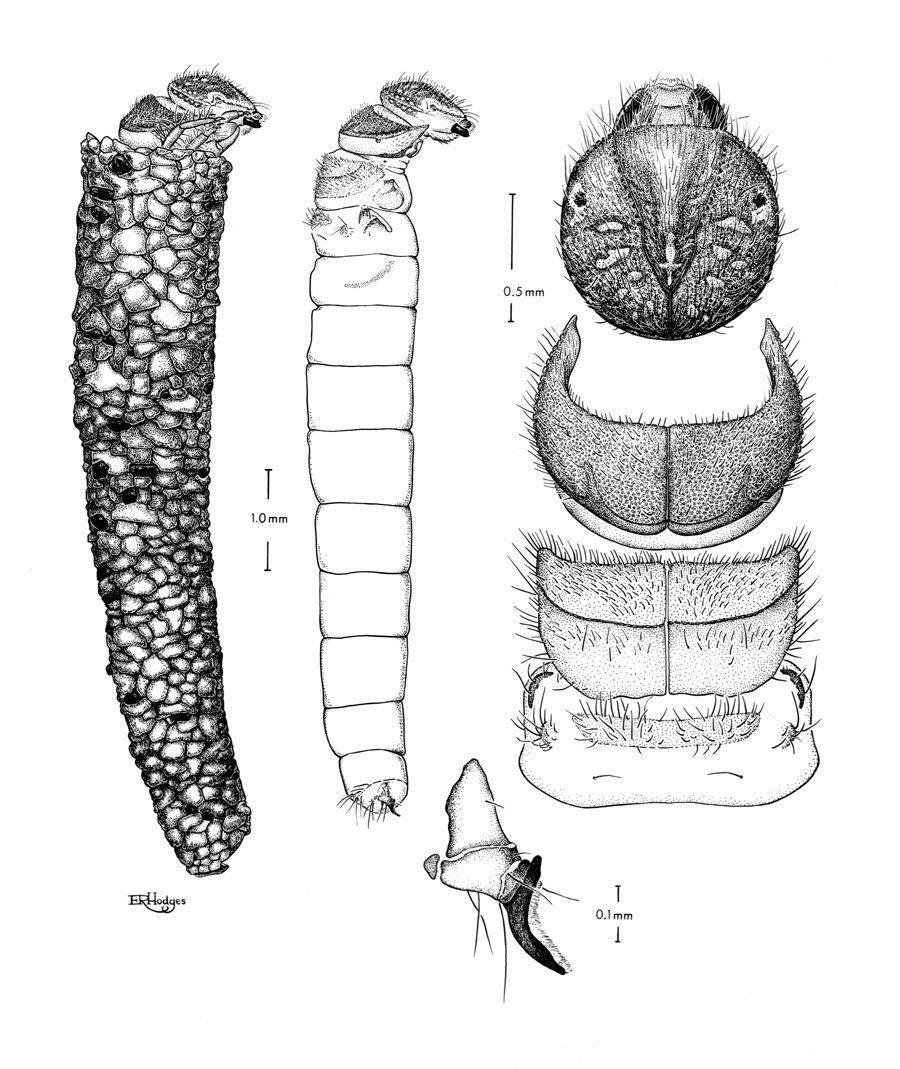
C. penalii, Caddisfly plate, larva: head and larval cases of Contulma penaii drawn for Oliver S. Flint (unpublished). ©Smithsonian Institution
When Ron retired in 1997, he and Elaine traveled around the country, seeing many possible locations to spend their retirement years. They finally settled on Eugene, Oregon, which had a perfect climate for the gardening Ron wanted to do, and attractive local cultural opportunities. It was hard for Elaine to leave so many friends on the east coast, but it turned out that many visited her on the west coast, and she made many friends there.
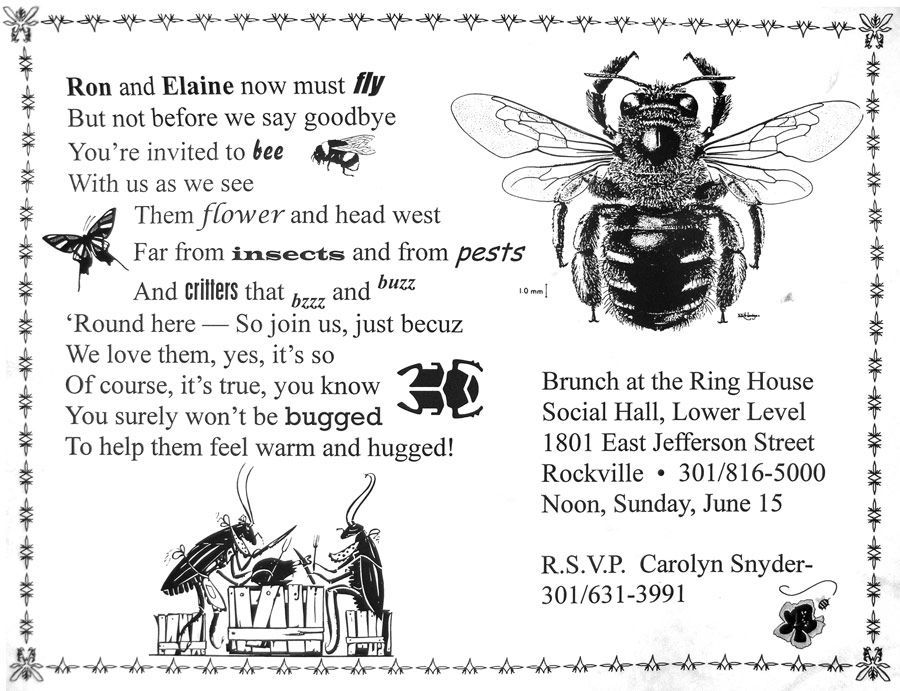
Left: Going-away party invitation for Elaine and Ron’s move to Oregon, from Elaine’s sister Carolyn Snyder, June 1997.
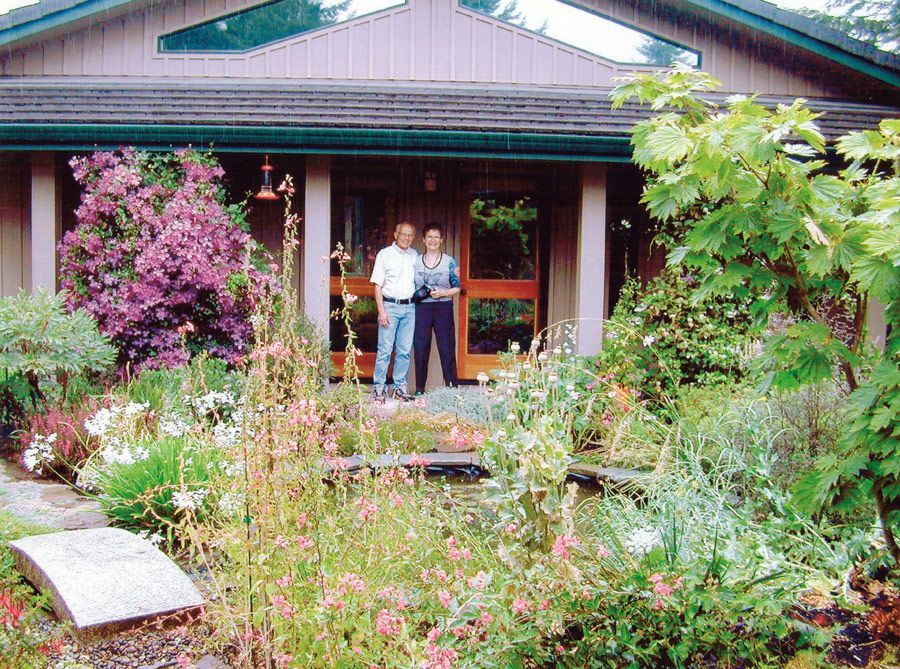
Right: Ron and Elaine at the courtyard entrance of their custom-built home in Eugene, OR, ~2003.
Life is not always what we want it to be, and Elaine ended up with less time on Earth than she deserved, but she stayed spiritually strong to the end. Elaine R. S. Hodges passed away in June 2006. There
was a Memorial Service for Elaine on the west coast, September 2, 2006 in Eugene Oregon, and a Memorial Service for her on the east coast, November 5, 2006 at the Smithsonian National Museum of Natural History, Washington D.C.—where Elaine’s artistic career blossomed and where she spent so many years creating beautiful images of nature, and encouraging and overseeing the growth of the Guild.
It’s such a pleasure to look back on the day of beginning in 1968. I among many members of the Guild miss the warmth, friendship, and brightness that both Elaine and Carolyn Gast brought to the Guild. Their example has been imprinted into the DNA of the Guild. The Guild has undergone quite a process of growth. It’s been a thrilling journey and continues as new members join the force to carry on. These two founders set up the Guild so it would last and grow. Carolyn and Elaine are gone, but the Guild is still going strong and I applaud them for their foresight.
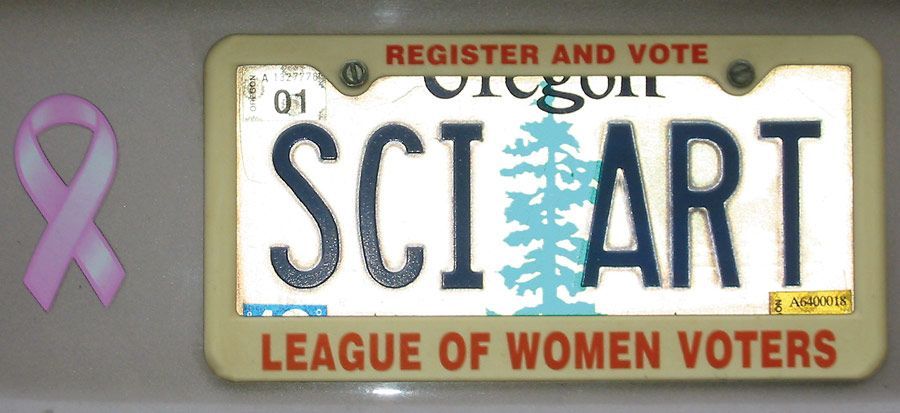
Elaine’s license plate, reflecting her passions.
Share this post:
